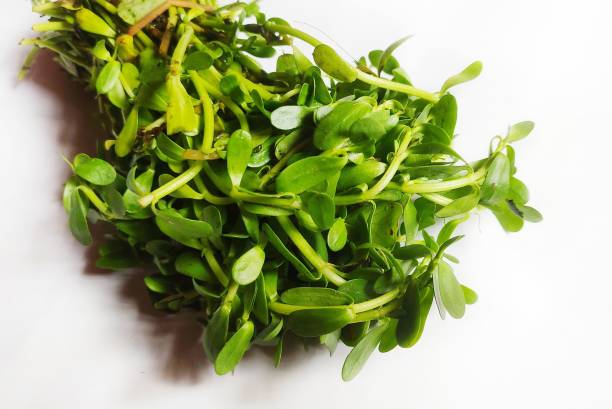

Bacopa monnieri (L.) Wettst.
|
It is commonly known as Brahmi and belongs to the Plantaginaceae family. Leaves and tender shoots are cooked and consumed as vegetable. Glycosides like Bacoside A, and alkaloids like Brahmine, Herpestine and Nicotine are some of the bioactive compounds reported from this plant. Bacoside has anti-inflammatory activity. Treatment with bacosides showed significant reduction in the age dependant elevation of IL-1β and TNF-α in Wistar rat brain as well as administraion of bacosides significantly down regulated iNOS expression in the middle aged and aged rat brain cortex. Mode of Consumption : Sauteed, fried and boiled |
| Plant Details | Agro-climatic Zone | Vernacular Names | Pictures |
| Scientific Name: Bacopa monnieri (L.) Wettst. Family: Plantaginaceae Juss. Class: Magnoliopsida Order: Lamiales Genus: Bacopa Aubl. Fruiting Season: October to May Parts: Leaves |
|
Andhra Pradesh : Sambarenu, Sambrani Assam : Brahmi Bihar : Mandukaparni Delhi : Mandukaparni Gujarat : Neerbrahmi, Bamanevari Haryana : Mandukaparni Jharkhand : Mandukaparni Kerala : Brahmi Madhya Pradesh : Mandukaparni Maharashtra : Jalnam, Brahmi Odisha : Brahmi Punjab : Brahmibuti Rajasthan : Mandukaparni Telangana : Sambarenu, Sambrani Tripura : Brahmisak Uttar Pradesh : Mandukaparni Uttarakhand : Mandukaparni |
 Plant |
| Compound/Extract | Activity | Mode of Action | Marker/References |
| Alkaloid extracts and Bacoside A | Anti-inflammatory | In vitro, tea infusion, alkaloid extracts and Bacoside A significantly inhibited the release of TNF-α and IL-6 from activated N9 microglial cells as well as in the cell free assay. They effectively inhibited caspase 1 and 3, and matrix metalloproteinase-3. | TNF-α and IL-6[1] |
| Bacoside | Anti-inflammatory | Treatment with bacosides significantly reduced the age dependant elevation of IL-1β and TNF-α in Wistar rat brain. Chronic administration of bacosides significantly down regulated iNOS expression in the middle aged and aged rat brain cortex. | IL-1β, TNF-α, and iNOS[2] |
| Triterpenoid and Bacoside | Anti-inflammatory | Triterpenoid and bacoside enriched fraction inhibited the lipopolysaccharide (LPS) induced TNF-α, IL-6 and nitrite production in mononuclear cells. | TNF-α, and IL-6[3] |
| Ethanolic extract | Anti-inflammatory | Ethanolic extract down-regulated NO and TNF-α in stimulated RAW 246.7 macrophages. | NO and TNF-α[4] |
| Bacopaside | Anti-inflammatory | Bacopaside reduced the elevated levels of IL-6 and TNF-α in 7-Ketocholesterol induced damage in Human Brain Endothelial Cells. | TNF-α and IL-6[5] |
| Major Class | Metabolites (Content of bioactives: mg/100g Fresh Weight) |
| Alkaloid | Brahmine: , Herpestine: , Nicotine: [6] |
| Flavonoid | Apigenin: , Luteonin: [7] |
| Glycoside | Asiaticoside: , Thanakunicide: [7] |
| Phenylethanoid glycoside | 3,4-dihydroxyphenylethyl alcohol (2-Oferulolyl)-β-D-glucopyronoside: [6] |
| Phenylethyl alcohol | 5-O-p-hyroxy-benzoyl-β-D-apifuranosyl-(1-2)-β-Dglucopyranoside: [6] |
| Phytochemical | Betulic acid: , Betulinic acid: , Oroxindin: , Wogonin: [7] |
| Phytosterol | Stigmastarol: , β-sitosterol: [7] |
| Pseudojujubogenin | 3-O-[α-1-arabinofuranosyl (1-2) β-d-glucopyranosyl]: [6] |
| Pseudojujubogenin glycoside | 3-O-α-Larabinofuranosyl-1(1-2)-[6-O-sulphonyl-β-D-glucopyranosil-(1-3)]-α-L-arabinopyranosyl pseudojujubogenin: , 3-O-α-L-arebinofuranosyl-(1-2)-[β-D-glucopyronosil-1(1-3)]β-D-glucopyranosyl pseudojujubogenin : [6] |
| Sapogenin | Jujubacogenin: , Pseudojujubacogenin: [7] |
| Saponin | 3-O-[α-1-arabinofuranosyl-1(1-2)]-α-L-arabino-pyrosyl jujubogenin: , Acid A: , Bacopasaponin: , Bacopaside: , Bacoside B: , D-mannitol: , Monnierin: [7] |
| Triterpenoid | Saponin 3-β-[O-β-D-glucopyronosyl (1-3)-O-[α-L-arabinofuranosy (1-2)]-O-β-D-glucopyranosyl)oxy] / Bacoside A3: [6] |
| Triterpenoid saponin | 20-dihydraoxy-16-keto-dammar-24-ene]: [6] |
| Triterpenoid saponins | Bacoside A [3-(α-L-arabinopyronsyl)-O-β-D-glucopyronaside]: [6] |
| Effect | Observation | DOI |
| Disease | Formulation | Reference | Author | TKDL |
| Chronic pyrexia, Colic, Vatadosa alleviating, Pittadosa alleviating . | Jvarabhairavarasa (02) | Bharata Bhaishajya Ratnakara - Vol.-II | Compiled by Naginadasa Chaganalala Shah, Translated by Gopinath Gupta | Ayurveda |
| Treatment of Tongue, Fever caused by all three dosa with equal severity. | Maadikaath | Bhaishajya Ratnavali | Govinda Dasa, Edited by Rajeshvaradutta Shastri, Translated by Ambikaduttashastri, Published by Chaukhamba Sanskrit Sansthan, Varanasi, Edn. 14th, 2001 | Ayurveda |
| Itching, Leprosy and other dermatoses, Ring worm, Perineal fistulas / Fistula-in-ano. | Medhyadhikaitalam | Bharata Bhaishajya Ratnakara - Vol.-IV | Compiled by Naginadasa Chaganalala Shah, Translated by Gopinath Gupta | Ayurveda |
| Stone in Urinary Bladder / Urolithiasis / Urinary Calculus, Dysuria, Retention of urine, Disease with Vata predominance | Veeratarvadigan Kwath | Sharangadhara Samhita | Shailaja Srivastava | Ayurveda |
| Infertility | Karpathirku Nei | 18 Siddhar chillarai kkovai, Ed. Ramachandran | Annonymous | Siddha |
| Information from Wealth of India | Reference |
|
CSIR(1948).The Wealth of India, Raw materials,Vol.-I ,P.143, New Delhi, India |
| 4.2, 4.2.1, 4.2.1.1, 4.2.1.3, 4.2.2.8, 4.2, 4.2.1, 4.2.1.1, 4.2.1.3, 4.2.2.8 |
| CSIR-North East Institute of Science and Technology, Jorhat-6, Assam, India
CSIR-Institute of Himalayan Bioresource Technology, Palampur-61,Himachal Pradesh, India |